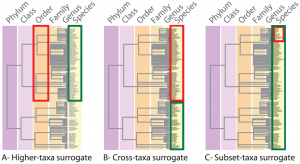 One of the most important components of conservation ecology is arguably the focus on robust methods to predict ‘biodiversity’. This covers everything from detection issues (whether or not a species is in a particular area), species distribution models (to predict where a species should be given habitat and/or physical attributes), climate change predictions, to reserve design algorithms (to assess whether we are protecting what we think we are protecting).
One of the most important components of conservation ecology is arguably the focus on robust methods to predict ‘biodiversity’. This covers everything from detection issues (whether or not a species is in a particular area), species distribution models (to predict where a species should be given habitat and/or physical attributes), climate change predictions, to reserve design algorithms (to assess whether we are protecting what we think we are protecting).
It might seem a bit strange to the uninitiated that we have to spend so much time trying to figure out what’s there. Surely, one just goes to the area of interest and does a few quick surveys? Wouldn’t that be lovely; the truth is that most species are, in fact, rare, and the massive areas we must usually survey tend to preclude complete coverage. This is why experimental design and statistical techniques are so advanced in our discipline – to account for the probability of missing what’s actually there, and to estimate what should be in areas we haven’t even looked in.
One way we deal with some of these issues is through the use of what we call ‘surrogates’. In an ecological context, a ‘surrogate’ is a component of the entire biodiversity that one can more easily measure than others, that is used as an indicator of the greater biodiversity in a particular area. For example, let’s say a particular species is relatively easy to survey, say, a tree that you could identify from aerial photos. If you could establish that many types of species live on or near such trees, then you’d have a relatively easy way of estimating biodiversity patterns over an entire forest just from inventorying that particular tree’s distribution. It’s rarely that straight-forward, but you get the general idea.
So it’s with great (and modest ;-) pleasure that I highlight a paper on this very subject of surrogacy in the marine realm. Interestingly, surrogacy studies have largely focussed on terrestrial questions to date, probably because data are generally more forthcoming compared to marine ecosystems; however, good surrogates are generally much more essential in marine ecosystems for that very same reason.
My post-doc, Camille Mellin, recently published a meta-analysis paper on marine surrogacy to determine if any generalities exist (see also a previous post on Camille’s exciting work). The paper appeared in PLoS One last month: Effectiveness of biological surrogates for predicting patterns of marine biodiversity: a global meta-analysis.

- spatial scale categories ranged from small (< 10 km), to medium (10 – 100 km), to large (> 100 km)
- habitat types were: tropical reefs, temperate reefs or soft bottoms
- surrogate types were: cross-taxa, higher-taxa or subset-taxa (see figure)
- statistical approaches were: univariate congruence, multivariate congruence, or representation
Overall, and rather unsurprisingly, we found that surrogate effectiveness is generally less than that assumed, but that there a few things one can do to improve predictive capacity. First, using higher-taxa surrogates (i.e., an entire class or genus for a group of species) was much better than using cross- or subset-taxa surrogates (again, see figure). One should also avoid representation-based surrogates (i.e., those that select a set of sites based on a surrogate and sum the representation of the target within the selected set), and those applied across broad spatial scales. Finally, tropical reefs had the poorest performance, most likely because of the high diversity and functional complexity found there relative to most other marine habitats.
So, if you’re designing a reserve based on surrogate data, make sure you account for the uncertainty in your biodiversity predictions based on the type of surrogates used. It could make the differences between extinction and persistence.
CJA Bradshaw
![]()

